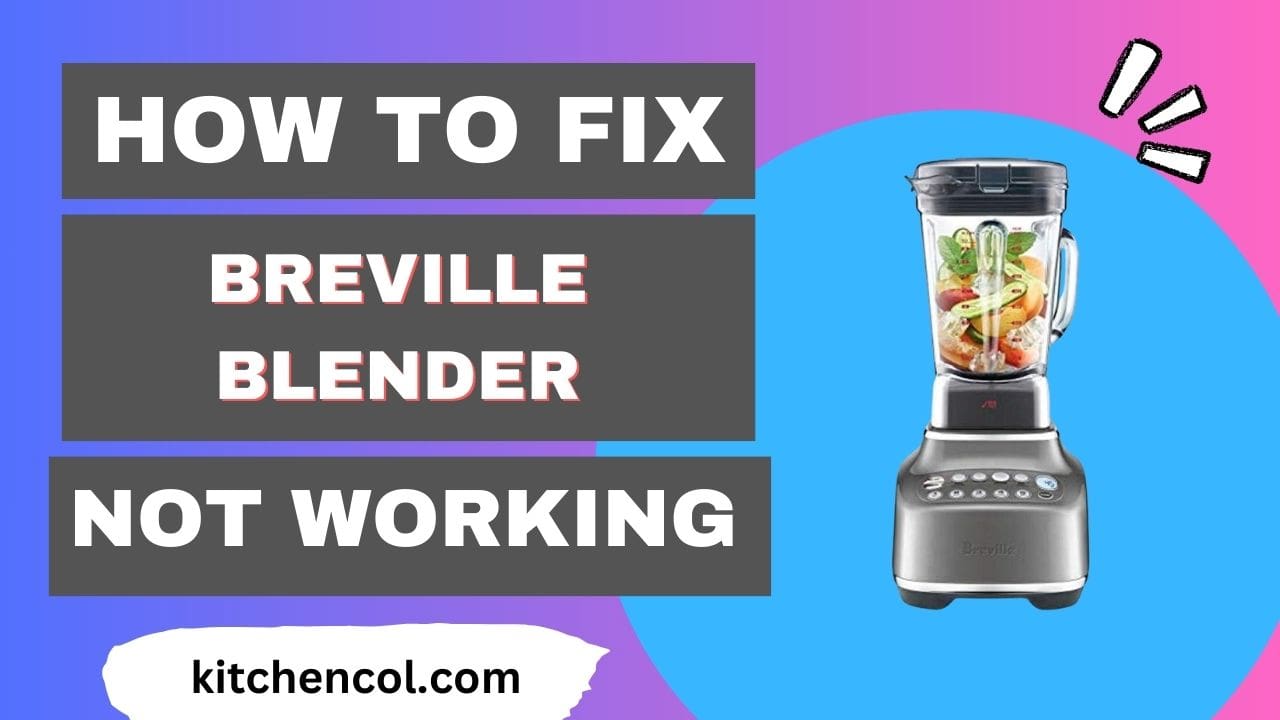Breville blenders are renowned for their performance, durability, and the ability to whip up delicious smoothies, soups, and more with ease. However, like any appliance, they can encounter issues from time to time, leaving you puzzled and without your favorite kitchen companion. In this blog post, we will guide you through the troubleshooting process when your Breville blender is not working as expected.
Whether it’s refusing to turn on, making strange noises, or failing to blend ingredients smoothly, we’ve got you covered with practical solutions to get your blender back in action. Say goodbye to blender woes and hello to culinary adventures as we delve into the world of Breville blender troubleshooting.
Common Breville Blender Problems
Blender Not Turning On:
- Possible Causes:
- Unplugged or loose power cord.
- Faulty power outlet.
- Safety features activated (e.g., lid not properly secured).
- Troubleshooting Steps:
- Check the power source and ensure it’s plugged in securely.
- Test the outlet with another device to confirm it’s functional.
- Verify that all safety mechanisms are properly engaged.
- Possible Causes:

Motor Running but Blades Not Moving:
- Possible Causes:
- Stuck or blocked blades.
- Issues with the jar assembly.
- Damaged or worn-out drive coupling.
- Troubleshooting Steps:
- Turn off and unplug the blender.
- Inspect for any obstructions in the blades.
- Examine the jar assembly for misalignment or damage.
- Check the condition of the drive coupling and replace if necessary.
- Possible Causes:
Blender Leaking:
- Possible Causes:
- Worn-out or damaged gasket in the jar base.
- Improperly assembled jar components.
- Cracks or damage in the blender jar.
- Troubleshooting Steps:
- Examine the gasket in the jar base for wear or damage and replace if needed.
- Ensure all jar components are properly assembled and tightened.
- Inspect the blender jar for any visible cracks or defects.
- Possible Causes:
Strange Noises Coming from the Blender:
- Possible Causes:
- Loose or misaligned parts.
- Lack of lubrication in moving components.
- Troubleshooting Steps:
- Identify the source of the noise and tighten or reposition loose parts.
- Lubricate any moving components following the manufacturer’s guidelines.
- Possible Causes:
Not Blending Ingredients Properly:
- Possible Causes:
- Incorrect blending speed.
- Improper placement of ingredients in the jar.
- Challenging ingredients that require special handling.
- Troubleshooting Steps:
- Adjust the blender speed to suit the ingredients being blended.
- Ensure ingredients are placed correctly, with liquids at the bottom.
- Consider using the blender’s pulse function for tough ingredients.
- Possible Causes:
By addressing these common issues step by step, you can often resolve problems with your Breville blender without the need for professional assistance. In the following sections, we will provide detailed troubleshooting instructions for each of these problems to help you get your blender back to its blending best.
Troubleshooting Steps
Blender Not Turning On:
- Check the Power Source:
- Make sure that the blender is connected to a working power outlet properly.
- Inspect the Power Cord and Plug:
- Examine the power cord for damage or fraying and replace if necessary.
- Look for any wear or damage on the plug.
- Examine Safety Features:
- Verify that the blender’s safety features, such as the lid sensor, are engaged correctly.
- Check the Power Source:
Motor Running but Blades Not Moving:
- Turn Off and Unplug the Blender:
- Safety first; always unplug the blender before working on it.
- Check for Obstructions:
- Look for any food or debris that may be blocking the blades.
- Gently remove obstructions using a tool or utensil.
- Inspect the Jar Assembly:
- Ensure that the blender jar is properly aligned with the base and locked into place.
- Examine the Drive Coupling:
- Remove the jar from the base and inspect the drive coupling (the part that connects the jar to the motor).
- Replace it if it shows signs of wear, such as cracks or wear on the teeth.
- Turn Off and Unplug the Blender:
Blender Leaking:
- Turn Off and Unplug the Blender:
- As always, start by disconnecting the power source.
- Check the Jar Base Gasket:
- Remove the jar from the base and inspect the gasket in the jar base for any wear or damage.
- Replace the gasket if necessary.
- Ensure Proper Assembly:
- Make sure all jar components, including the lid and blade assembly, are correctly assembled and tightened.
- Inspect the Blender Jar:
- Look for visible cracks or damage on the blender jar itself. If found, replace the jar.
- Turn Off and Unplug the Blender:
Strange Noises Coming from the Blender:
- Identify the Noise Source:
- Pay attention to where the strange noise is coming from (e.g., motor, blades, jar).
- Tighten Loose Parts:
- If the noise is due to loose components, such as the jar or base, tighten them securely.
- Lubricate Moving Parts:
- If the noise persists, consult your blender’s manual for guidance on lubricating moving parts like bearings or bushings.
- Identify the Noise Source:
Blender Not Blending Ingredients Properly:
- Adjust Blending Speed:
- Use the appropriate speed setting for the ingredients being blended. Low for soft ingredients, high for harder ones.
- Proper Ingredient Placement:
- Always place liquids at the bottom of the jar, followed by softer ingredients and then harder ones.
- Avoid overfilling the jar.
- Use the Pulse Function:
- For tough ingredients like ice or frozen fruits, use the pulse function to avoid overstraining the motor.
- Adjust Blending Speed:
By following these troubleshooting steps, you can often diagnose and resolve common issues with your Breville blender. However, if your blender problems persist or if you suspect a more complex issue, it may be best to contact Breville’s customer support or visit an authorized service center for professional assistance.
Maintenance Tips
Regular Cleaning:
- After each use, disassemble the blender components (jar, lid, blades) and wash them thoroughly with warm, soapy water.
- Use a brush or sponge to clean hard-to-reach areas, such as around the blade assembly.
- Rinse and dry all components before reassembling.
Avoid Overfilling:
- Pay attention to the maximum fill line marked on your blender jar. Overfilling can strain the motor and lead to performance issues.
- When blending, add ingredients in small batches, especially if you’re working with dense or tough items.
Proper Storage:
- Store your blender in a cool, dry place when not in use.
- To avoid the growth of mold or mildew, make sure that all of the components are dry before storing.
Regular Inspections:
- Check the plug and power cable on a regular basis for wear or damage. Replacing them right away if you see any problems is advised.
- Check the blender jar for cracks or damage. If you find any, replace the jar to avoid leaks or safety concerns.
Lubrication (if applicable):
- Consult your blender’s user manual for information on lubricating moving parts. Some blenders may require occasional lubrication to maintain smooth operation.
Avoid Overheating:
- To prevent the blender motor from overheating, avoid running it for extended periods without breaks.
- If you notice the motor getting excessively hot during use, turn it off and let it cool down before continuing.
Use the Right Blades:
- Ensure you’re using the appropriate blades for the type of blending you’re doing. Some blenders come with multiple blade options for different tasks.
Replace Worn Parts Promptly:
- If you notice any wear and tear on components like gaskets, seals, or drive couplings, replace them promptly to maintain the blender’s integrity and prevent issues.
Follow the Manufacturer’s Guidelines:
- Always refer to the user manual provided by Breville for specific maintenance instructions and safety precautions.
Regularly Clean the Base:
- Wipe down the blender’s base with a damp cloth as needed to prevent the buildup of dust or spills that could affect its operation.
By following these maintenance tips, you can ensure that your Breville blender remains in excellent working condition and continues to serve you with smooth and consistent blends for years to come. Remember that proper care and maintenance are key to maximizing the lifespan and performance of your kitchen appliances.
When to Seek Professional Help
While many common Breville blender issues can be resolved through troubleshooting and routine maintenance, there are situations where it’s wise to seek professional help:
- Persistent Problems: If you’ve attempted troubleshooting steps multiple times without success, it’s an indication that a deeper issue may be at play.
- Electrical or Safety Concerns: If you suspect electrical issues, such as a malfunctioning motor or exposed wires, or if there are safety concerns like strange odors or smoke coming from the blender, immediately cease use and seek professional assistance to avoid potential hazards.
- Warranty Coverage: If your Breville blender is still under warranty, it’s advisable to contact Breville or an authorized service center for repairs. Attempting DIY fixes may void your warranty.
- Complex Repairs: Some problems, such as motor replacement or extensive internal repairs, require specialized knowledge and tools. It’s safer and more cost-effective to let professionals handle such tasks.
- Unusual Noises or Vibrations: Unusual sounds or vibrations that persist after attempting basic troubleshooting may indicate underlying mechanical issues best addressed by experts.
In these cases, reaching out to Breville’s customer support or an authorized service center is the prudent choice to ensure the safety, performance, and longevity of your blender.
Also Read: How to Fix Whirlpool Oven Bottom Element Not Working
Conclusion
Troubleshooting and maintaining your Breville blender is an essential part of ensuring its longevity and optimal performance. By addressing common issues such as power problems, blade malfunctions, leaks, unusual noises, and blending difficulties with the right steps and regular maintenance, you can often restore your blender to its former glory.
However, it’s equally important to recognize when it’s time to seek professional help, especially in cases involving electrical concerns, complex repairs, or persistent issues that elude DIY fixes. Safety should always be a top priority, and professional assistance may be the safest course of action.
By following the maintenance tips provided and staying vigilant for signs of wear and tear, you can extend the life of your Breville blender and continue to enjoy its culinary capabilities for years to come.
Remember, your Breville blender is a valuable kitchen tool, and with the right care and attention, it will continue to serve you delicious smoothies, soups, and more, making your culinary adventures both enjoyable and hassle-free.

My name is Manan Bukhari and I am an expert in reviewing kitchen products for years. I have a passion for testing multiple gadgets especially related to home & kitchen. I love to spend my free time in resolving issues if I face some in any of my daily use things. I have fixed multiple gadgets of my home on my own without any assistance and that thing gave me confidence to make a blog on troubleshooting of items that are for daily use to assist you folks. Even my wife praises me for having such talent. I always explore new machines on my own because this thing fascinates me.



